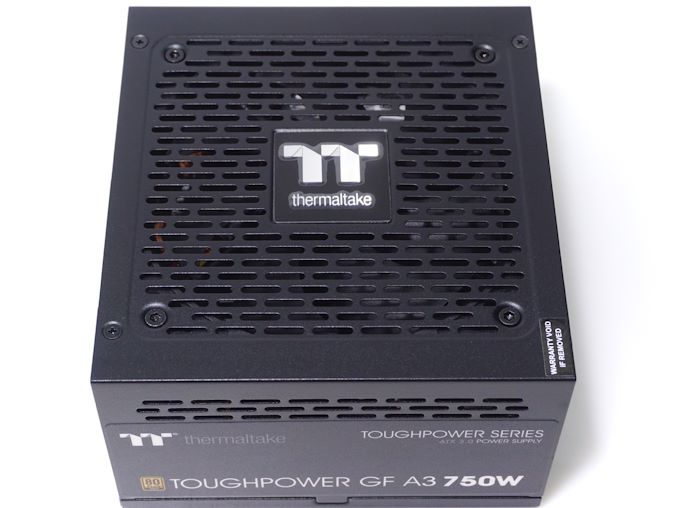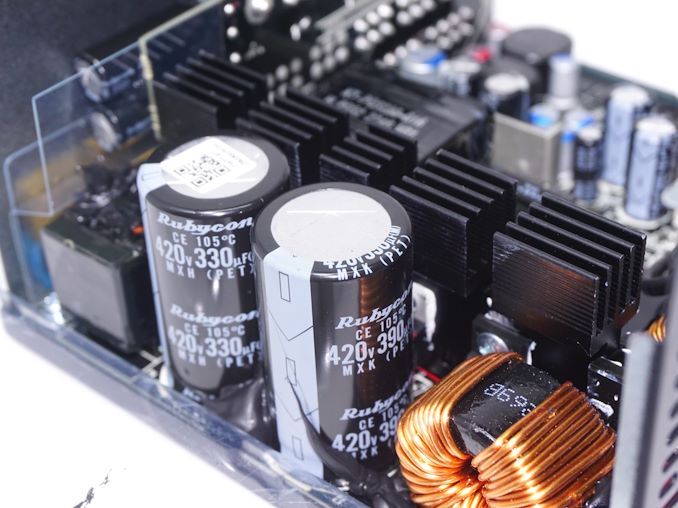The Thermaltake Toughpower GF A3 750W PSU Review: Mid-Range 750W PSU With 12VHPWR
by E. Fylladitakis on October 23, 2023 10:00 AM ESTPower Supply Quality
As part of our testing, we also check output parameters are within specifications, as well as voltage ripple and line noise.
| Main Output | ||||||||
| Load (Watts) | 152.34 W | 380.02 W | 567.03 W | 754.13 W | ||||
| Load (Percent) | 20.31% | 50.67% | 75.6% | 100.55% | ||||
| Amperes | Volts | Amperes | Volts | Amperes | Volts | Amperes | Volts | |
| 3.3 V | 1.8 | 3.4 | 4.5 | 3.38 | 6.75 | 3.37 | 9 | 3.36 |
| 5 V | 1.8 | 5.11 | 4.5 | 5.09 | 6.75 | 5.05 | 9 | 5.03 |
| 12 V | 11.25 | 12.18 | 28.14 | 12.15 | 42.2 | 12.09 | 56.27 | 12.06 |
| Line | Regulation (20% to 100% load) |
Voltage Ripple (mV) | |||||
| 20% Load | 50% Load | 75% Load | 100% Load | CL1 12V |
CL2 3.3V + 5V |
||
| 3.3V | 1.1% | 10 | 14 | 16 | 16 | 16 | 18 |
| 5V | 1.4% | 16 | 18 | 16 | 20 | 16 | 20 |
| 12V | 1% | 22 | 16 | 18 | 28 | 24 | 20 |
The electrical performance of the Toughpower GF A3 750W is as good as Thermaltake advertises, which is very good overall for a mainstream product. We measured a voltage ripple of 28 mV on the 12V line at maximum load, which is exceptional for a product of this class and with a so high operating temperature. Filtering on the 3.3V and 5V lines is very good, too, with a maximum ripple of 16 mV and 20 mV, respectively. Voltage regulation is just above average, at 1% on the major 12V line and slightly worse on the 3.3V/5V lines. What is worth mentioning here is that the voltage on all lines is a bit higher than usual but within the ATX 3.0 design guide specifications.
As part of our standard testing, we test the primary protections of all PSUs we review (Over Current, Over Voltage, Over Power, and Short Circuit). All of the Thermaltake Toughpower GF A3 750W protections engaged as they would normally. It is worth mentioning that the OCP protection kicks in very quickly for an ATX 3.0 design, almost immediately if the 12V rail current reaches over 75A. Due to the expected power excursions, we were used to seeing much more lax settings with ATX 3.0 designs. Still, considering the 300W power limit of the 12VHPWR connector here, the sharp OCP protection will not cause any problems and is safer for both the PSU itself and the powered components.
Conclusion
In conclusion, the Thermaltake Toughpower GF A3 presents itself as a robust contender in the PC power supply market, offering a judicious blend of performance, quality, and aesthetics. The build quality is commendable, featuring a premium all-black exterior, fully modular cables, and high-grade Japanese APFC capacitors. The secondary capacitors from CapXon also maintain a high standard. However, it's worth noting that the active components from lesser-known Chinese manufacturers raise a modicum of concern due to the lack of publicly accessible datasheets.
From an electrical engineering standpoint, the power quality stands out. The unit adheres to the ATX 3.0 design guide requirements and showcases praiseworthy voltage filtering capabilities, ensuring voltage ripple values below 30 mV even under significant stress. While the voltage output is marginally high, it stays within acceptable limits. The unit ostensibly meets 80Plus Gold energy conversion efficiency requirements at an input voltage of 115VAC, although formal certification for this model remains unpublished.
Thermal performance is one area where compromises have been made, seemingly to prioritize low-noise operation. While the unit runs at high operating temperatures, there is minimal evidence of thermal stress, which attests to its well-engineered design. Noise levels remain impressively low, making the PSU a viable option for those who require a quiet working environment. However, this comes at the cost of elevated thermal readings, primarily due to the small and slow fan.
The Thermaltake Toughpower GF A3 offers a fair proposition in terms of overall value. Priced at $91 on Amazon, the PSU provides an attractive quality, performance, and aesthetic appeal package. It suits mid-range gaming systems and workstations well but is in a fiercely competitive market segment. Thermaltake's own advanced PSU series, which is priced only slightly higher, serves as formidable competition.
In summary, this unit is a persuasive option that offers a balanced blend of key performance attributes, making it a viable choice for those seeking a quality, efficient, and relatively quiet power supply unit. A slightly lower retail price would tremendously help the Toughpower GF A3 find its rightful place in the market.













10 Comments
View All Comments
meacupla - Monday, October 23, 2023 - link
I find it interesting that TT doesn't use their toughfan in this. The 120mm version has good static pressure, which seems ideal for a PSU. Especially when it has a restrictive stamped finger guard.Samus - Monday, October 23, 2023 - link
Probably just money. I have been constantly let down by mid-range PSU fans and I get it, they need to cut corners somewhere, but the fan is arguable the most important part because its naturally, being mechanical, should be the only component that will eventually fail. And they constantly do.I recently replaced a 120mm fan in a Seasonic Focus. You would think anything Seasonic would be of exceptional quality but the fan started chattering, and at closer inspection the axial shaft in the motor disconnected from the fan housing and would be very difficult to repair (and not worth repairing for such a junk FDB fan)
Disturbingly these fans are used in their top-dollar Prime PSU's and upon research, people do have failures. While Seasonic has a 10 year warranty, even if you can provide proof of purchase and are willing to send it in and wait a week or two for RMA, is it worth it to get a PSU with the same crappy fan back when you can upgrade it to a superior fan for $10.
Obviously I chose to replace it with a better fan, which revealed another problem. The fan controller of the PSU is calibrated for the specific power draw of the fan, in my case it was 0.58A. I installed a Noctua 120mm fan that draws only 0.05A, and it runs at full speed all the time making more noise than any other component in my PC because the PSU is expecting a 0.58A fan. The Prime PSU's have a silence button that doesn't run the PSU fan until it's needed (power draw\temp at a certain threshold) but the Focus lack this button, so it's just whizzing away at full speed all the time.
All of this could have been avoided if they just used a good fan, but again, it's a $100 PSU, I realize compromises had to be made. But when you consider this same crappy fan is used in their $300 PSU's, I'd be pretty damn pissed if this fan failed in one of those because you expect a quality ball bearing fan or something when spending top dollar.
My PC Power & Cooling 750 Quad has an 80mm ADDA Ball Bearing fan and is subjectively silent compared to most other comparable modern PSU's. And it's 15 years old.
back2future - Monday, October 23, 2023 - link
[ on a 50mA current You could possibly install series resistors being a voltage divider to the fan's supply voltage, what might give You some control for adjustments on rpms(?) ]Samus - Tuesday, October 24, 2023 - link
I thought about adding a resistor or a rheostat, but since this isn't a modular PSU it's a pain in the ass to remove and I've decided to just live with the fan noise. It isn't loud enough to be a bother (this is a 1600rpm Noctua fan) but it's annoying in doing so I made the quietest component of my PC the loudest at idle.It's my fault for lapsing on the fact I was dealing with a 2-pin fan that would obviously be miscalibrated to a control circuit designed for an entirely different fan.
back2future - Tuesday, October 24, 2023 - link
[ You even need to cut the org. fan cable, since for a $1-2 there are extension cords 'https://ae01.alicdn.com/kf/S4616494b80094bcb816bcb... or connect that power supply fan with a mainboard pwm controller for load dependent rpm control, if 12V, therefore having a configurable, spare fan port or a (split) extension cable 'https://images-eu.ssl-images-amazon.com/images/I/7... ]back2future - Tuesday, October 24, 2023 - link
[ meant: 'even need not to cut the org. fan cable' ]Samus - Monday, October 23, 2023 - link
With the 4070Ti being a 285w TDP card and the 12vHPWR connector rated at 300w, does the aggressive OCP pose a threat to premature power cutoff if the card happens to spike above 300w? I feel that the 4070Ti is a realistic pairing with this PSU.love2fly59 - Tuesday, October 24, 2023 - link
Please excuse my newbie question but how can this be possible:"The efficiency curves would easily allow the PSU to receive an 80Plus Gold certification for an input voltage of 115 VAC. Still, it would not be able to receive the same certification for an input voltage of 230 VAC as it could not reach an efficiency greater than 92% at half load"
when the efficiency curves in this test show that 230 VAC efficiency measurements are consistently better than those for 115 VAC?
love2fly59 - Tuesday, October 24, 2023 - link
Can it be that 115 VAC has lower efficiency requirements than 230 VAC?MachineLearning - Wednesday, October 25, 2023 - link
Power supplies operating on 230v are generally more efficient than when they operate on 115v / 100v. Therefore 80plus and Cybenetics standards for efficiency are higher for 230v than 115v, since a lower quality power supply could theoretically be 80plus Gold on 230v but only Silver or Bronze on 115v. The seemingly stricter requirements are to account for this.Hope this helps.